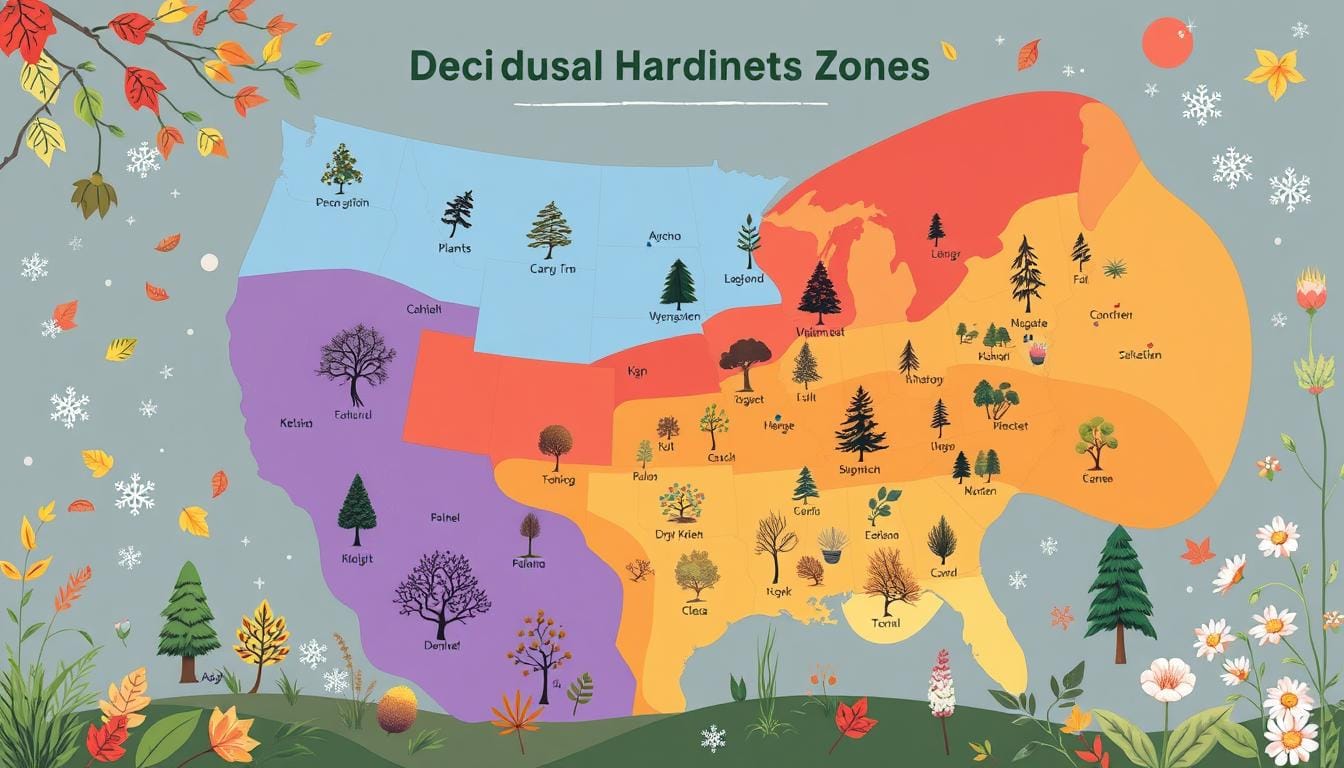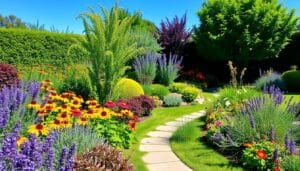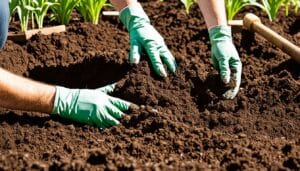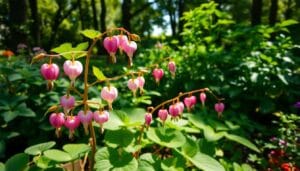Gardening fans and plant enthusiasts know how important hardiness zones are. The USDA Plant Hardiness Zone Map divides the U.S. and Canada into 11 zones. These zones are based on the lowest winter temperatures each area sees.
This map, made from data from 1974 to 1986, helps figure out which plants will grow back year after year. It’s a key tool for gardeners to pick the right plants for their area.
Key Takeaways
- The USDA Plant Hardiness Zone Map categorizes regions based on their lowest average winter temperatures.
- Knowing your hardiness zone is crucial for selecting plants that will survive and thrive in your local climate.
- The same zones apply to annuals, perennials, shrubs, and trees, guiding gardeners in their plant choices.
- Factors such as soil, moisture, and microclimate can also impact a plant’s survival beyond its hardiness zone.
- Container gardening requires selecting plants that are two zones hardier than your local zone.
What is a Deciduous Plants Hardiness Zone
A deciduous plant’s hardiness zone is a specific area with certain climates. The USDA has a map with thirteen zones in the United States. These zones help choose the right plants for each region.
Definition and Basic Concepts
The USDA hardiness zone system helps gardeners and horticulturists. It shows which plants can handle the local climate. Each zone has a 10°F difference, and “a” and “b” segments offer a 5°F distinction.
The zones are based on the average winter temperatures. This info is key for understanding the needs of deciduous trees and other plants.
Importance in Plant Selection
Choosing the right hardiness zone is vital for plant selection. Plants that match your local climate will thrive. Those that don’t may not survive the cold.
By picking plants suited to your area, you ensure their success. This saves you from the hassle and cost of replacing them.
Impact on Plant Survival
The hardiness zone system greatly affects plant survival. Plants in their optimal zone can handle local extremes better. Those outside their zone may struggle or die in harsh weather.
“Understanding and utilizing the USDA hardiness zone system is crucial for the long-term success of your garden and landscape.”
The History and Development of USDA Hardiness Zones
The idea of plant hardiness zones started in the early 1900s. The first map with 8 zones was made in 1927 by Dr. Alfred Rehder at the Arnold Arboretum. Then, in 1938, Dr. Donald Wyman updated it with data from 1895 to 1935.
In 1960, the USDA published its first map, using data from 450 weather stations. This map helped gardeners and horticulturists a lot. The 1990 map was even more detailed, thanks to the US National Arboretum and 4,800 to 14,500 weather stations.
The 2023 update of the USDA Hardiness Zone Map is more accurate. It uses data from all over the US. The zones are divided into 20, with a and b subcategories for finer details.
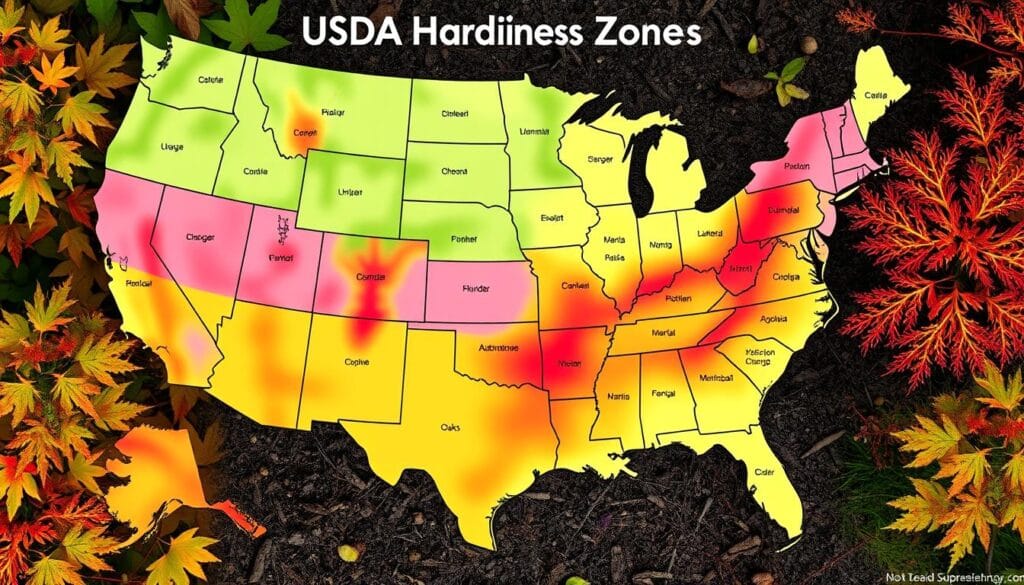
Many things affect how well plants do, like winter cold, summer heat, and snow. Where a plant comes from also matters, especially for trees and shrubs. But, plants grown from the same seeds stay the same, no matter where they’re grown.
The USDA Hardiness Zone Map is still key for gardeners today. It helps pick the right plants for your area’s climate and small spots in it.
How Plant Hardiness Zones are Determined
Plant hardiness zones help gardeners and landscapers know the best conditions for plants. These zones are based on the average winter temperature. The USDA uses climate data from many years to set these zones, from 1 to 13. Subzones have letters a or b, showing a 5-degree difference.
Temperature Measurements
The USDA Hardiness Zone Map uses the average winter temperature. For example, Bangor is zone 5a, with temperatures between -20 and -15 degrees Fahrenheit. This helps gardeners pick plants that can survive the winter.
Climate Data Collection
The USDA gathers data from thousands of weather stations to map hardiness zones. They consider elevation, latitude, and distance to water bodies. These factors affect a region’s temperature.
Geographical Factors
Geographical factors, like elevation, are key in determining hardiness zones. Denver is zone 6, but Summit County, higher up, is zone 5a-4b. Knowing your area’s climate is vital for choosing plants.
| Location | USDA Hardiness Zone | Average Minimum Temperature Range |
|---|---|---|
| Bangor, Maine | 5a | -20 to -15°F |
| Denver, Colorado | 6 | -10 to -5°F |
| Summit County, Colorado | 5a-4b | -20 to -25°F |
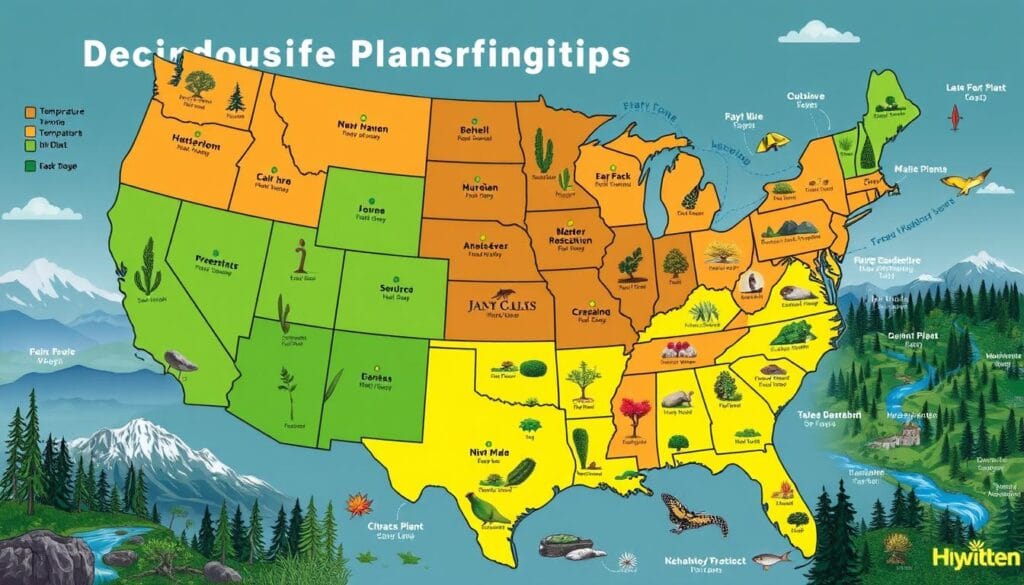
Knowing how plant hardiness zones are set helps gardeners choose the right plants. This knowledge is key for successful plant zoning and growing in different climates.
Understanding the USDA Zone Map Structure
The USDA Plant Hardiness Zone Map is a key tool for gardeners. It shows the United States divided into 10 zones based on temperature. This helps gardeners choose the right plants for their area.
The map is easy to use. Just enter your zip code to find your zone. The USDA also has maps for the whole country, regions, and states. This helps gardeners pick the best plants for their garden.
But, remember, the USDA zone map is just a guide. Things like local weather, soil, and moisture also matter. Gardeners should use the map as a starting point and think about these other factors too.
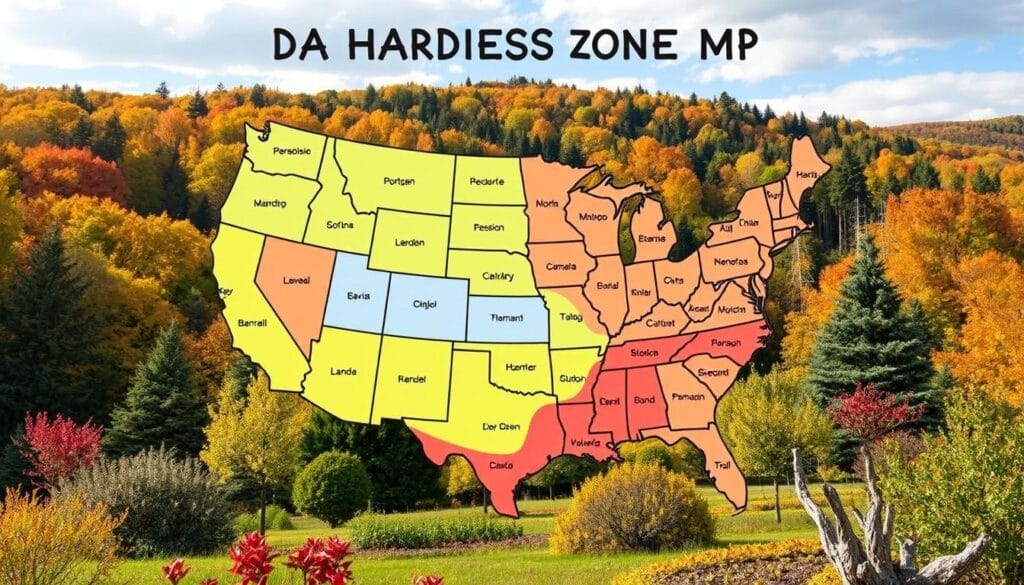
The USDA zone map is great for all gardeners. By understanding it and using it with other gardening tips, you can create a beautiful garden. It will make your outdoor space more enjoyable.
Temperature Ranges and Zone Classifications
The USDA updated their Plant Hardiness Zone Map to 13 zones, each 10 degrees apart. These zones help gardeners pick plants that can handle certain temperatures. As the climate changes, zones might shift, so gardeners need to adjust their plant choices.
Minimum Temperature Thresholds
Lower-numbered zones can handle colder weather, while higher numbers mean warmer climates. For example, Zone 7 ranges from 0-10°F. Subzone 7a has temperatures from 0-5°F, and subzone 7b from 5-10°F. These plant frost tolerance levels help gardeners make more precise choices.
Zone Variations and Subcategories
Other factors like winds, urban heat, rainfall, and humidity also affect plant growth. The USDA has identified 13 planting zones in the United States. Each zone has its own average low temperature range. This shows how different plants can thrive in various winter hardiness categories.
| USDA Zone | Average Annual Minimum Temperature Range (°F) |
|---|---|
| Zone 3 | -40 to -30 |
| Zone 4 | -30 to -20 |
| Zone 5 | -20 to -10 |
| Zone 6 | -10 to 0 |
| Zone 7 | 0 to 10 |
| Zone 8 | 10 to 20 |
| Zone 9 | 20 to 30 |
| Zone 10 | 30 to 40 |
| Zone 11 | 40 to 50 |
| Zone 12 | 50 to 60 |
| Zone 13 | 60 to 70 |
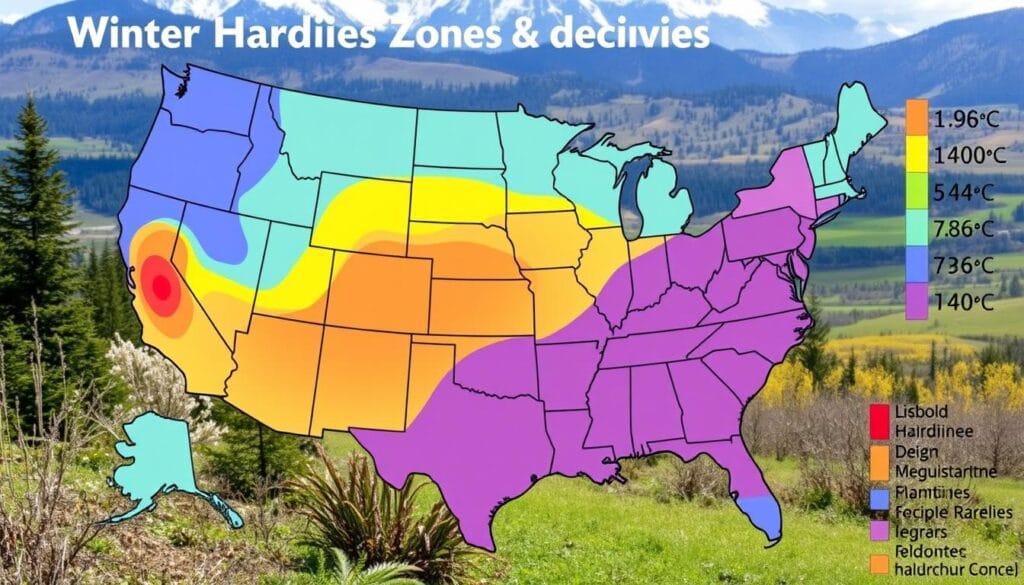
“The USDA Plant Hardiness Zones consist of thirteen bands with a 10-degree spread in temperatures, each further divided into two zones.”
Regional Variations in Plant Hardiness
Plant hardiness varies a lot within regions and even states. Things like elevation, water closeness, and city heat can change the climate. These changes can be different from the main zone classification.
The US Department of Agriculture has updated the Plant Hardiness Zone Map. It now has 13 zones, each 10 degrees Fahrenheit apart. The coldest zone is 1, with lows of -60°F to -50°F. The warmest zone is 13, with lows of 60°F to 70°F.
In Upstate New York, the planting zones change a lot. The Northern Adirondacks are in zones 4a to 4b. Plants like White Spruce, Red Maple, Dark Matter Salvia, and Astilbe do well here. Moving south, the Central and Western New York areas are in zones 5a to 6b. Plants like Sugar Maple, Forsythia, Fountain Grass, and daylilies thrive here.
In the Eastern New York and Hudson Valley areas, zones 5b to 6a are best. Plants like Dogwoods, Rhododendron, and tomatoes and peppers do well. The Southeastern New York region, zones 6a to 6b, is the mildest. It’s good for plants like Coneflowers, Magnolias, and Hydrangeas.
Knowing these regional hardiness variations is key for choosing the right plants. Soil, microclimates, and elevation also affect plant success. These factors can make a big difference in a specific area within the broader zones.
| Region | Hardiness Zones | Suitable Plants |
|---|---|---|
| Northern Adirondacks | 4a to 4b | White Spruce, Red Maple, Dark Matter Salvia, Astilbe |
| Central and Western New York | 5a to 6b | Sugar Maple, Forsythia, Fountain Grass, Daylilies |
| Eastern New York and Hudson Valley | 5b to 6a | Dogwoods, Rhododendron, Tomatoes, Peppers |
| Southeastern New York | 6a to 6b | Coneflowers, Magnolias, Hydrangeas |
By understanding these regional hardiness variations, gardeners and landscapers can choose the best places for their plants. This ensures their plants will thrive and landscapes will flourish.
Factors Affecting Plant Survival Beyond Zones
Hardiness zones are key when picking plants, but other factors matter too. The environment and climate zones affect how well plants grow. These factors help decide if a plant will thrive.
Soil Conditions
Soil type and quality are very important. Plants need soil that drains well and has the right nutrients and moisture. Adding amendments and mulch helps protect plants from extreme temperatures and gives roots what they need.
Moisture Levels
Plants need the right amount of water to grow and survive. Rainfall, irrigation, and snow cover all play a part. Plants may struggle in dry or wet spells, even if they fit the hardiness zone.
Microclimates
Microclimates, or small areas with different temperatures and humidity, affect plants. Buildings and landscape features can create these areas. Knowing about microclimates can help plants grow in unexpected places.
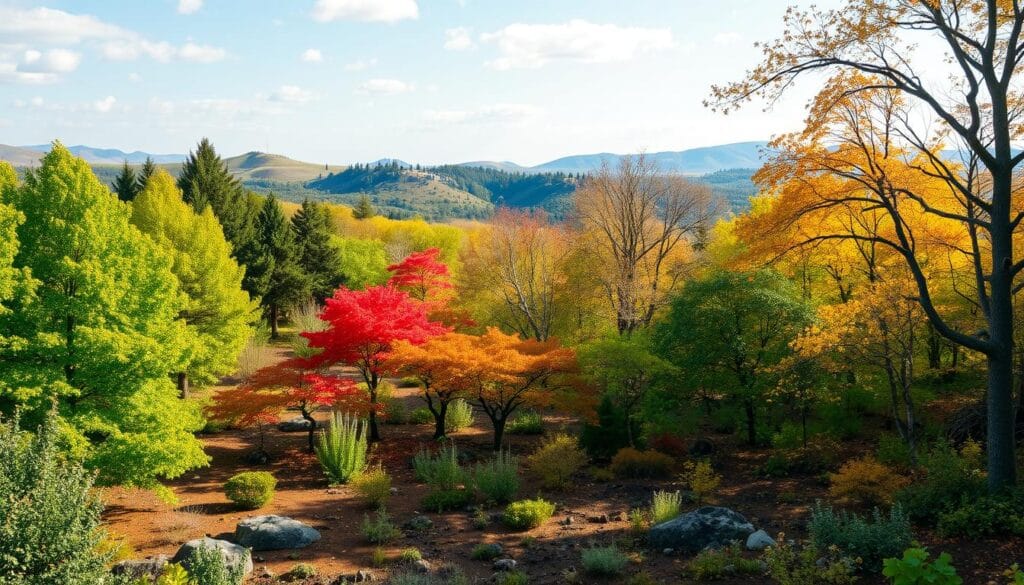
“While hardiness zones provide a valuable baseline, the environment conditions for deciduous trees and the overall growing zones by climate can vary greatly within a single zone. Paying attention to soil, moisture, and microclimates is essential for ensuring plant success.”
Container Growing and Hardiness Considerations
When growing plants in containers, it’s key to think about their plant frost tolerance levels and deciduous plant survival zones. Plants in pots are usually less hardy. This is because the soil in pots freezes more easily and thaws more often.
Plants in containers should be at least two zones hardier than your zone to make it through winter. Or, you can bury the containers in the ground to keep them warm.
It’s also vital to watch the soil moisture in container plants. They dry out faster than ground-grown plants. Water deeply once a week in the growing season and less in winter.
| Plant Variety | Hardiness Zone | Sun Exposure | Watering Requirements |
|---|---|---|---|
| Sunshine Ligustrum | 6-9 | Full sun to partial shade | Water when top inch of soil is dry |
| Orange Rocket Barberry | 5-9 | Full sun to partial shade | Water when top inch of soil is dry |
| Skylight Better Boxwood | 6-9 | Full sun to partial shade | Water when top inch of soil is dry |
When picking plants for containers, choose ones that fit your deciduous plant survival zones. They should handle your area’s temperatures and conditions. Taking good care, like fertilizing and pruning, helps them thrive in containers.
Selecting Plants for Your Hardiness Zone
When picking plants, knowing your climate is key. The United States Department of Agriculture (USDA) Hardiness Zone helps. It splits the country into 13 zones based on winter temperatures. This guides gardeners to choose the right plants for their area.
Reading Plant Labels
Always check the hardiness zone on plant labels. If your zone is the same or higher, the plant will likely grow back. Plants from colder zones can usually be planted in warmer ones, but not the other way around. Newer varieties might have different hardiness levels, so check the specific plant info.
Making Informed Choices
- Understand the importance of microclimates: Wind, humidity, and soil can affect a plant’s survival, even in the same zone.
- Consider the plant’s sun and water needs: Choose species that fit your landscape’s growing conditions.
- Prioritize native and adapted plants: They usually need less care and fit your local climate better.
- Consult local resources: Talk to your state’s cooperative extension or local nurseries for tailored advice for your area.
“Hardiness zones are a guide, but they’re not a guarantee. Knowing your local microclimate and picking the right plants is crucial for a thriving garden.”
By knowing your hardiness zone and choosing wisely, you can create a beautiful, lasting garden. It will flourish in your suitable planting regions.
Common Mistakes in Zone-Based Planting
The USDA Plant Hardiness Zone Map and the American Horticultural Society’s heat zone map are great tools. They help us pick the right plants for our area. But, we must avoid some common mistakes when planting by zone.
One big mistake is not looking at the subzones within each hardiness zone. These subzones can have very different temperatures and how well plants can survive.
Another error is planting plants from warmer zones in cooler ones. Even though some plants might survive, they often grow weaker. They may also produce fewer flowers or no fruit at all. Remember, hardiness zones are just a guide. Local conditions, like microclimates, can change how well plants do.
It’s also important to think about more than just how well plants do in cold. We need to consider their heat, drought, soil, and light needs. By understanding all these factors and our garden’s conditions, we can make better choices. This way, we can avoid common mistakes when picking plants based on their survival and hardiness zones.


